It’s usually pleasurable to pet a cat. But when you encounter a lump under your furbaby’s skin, it can be concerning. Fortunately, there are also several benign reasons for lumps and bumps in cats – including cysts. Cysts are small growths under the skin that may contain fluid, dead skin cells, or semi-solid materials. They are usually harmless and can arise from various causes including infections, a foreign body in the skin, or clogged oil ducts.
In this article, we’ll examine the major types of cysts (with pictures), and review causes, diagnosis, and treatment.
What is a cat cyst?
Cat cysts are benign masses that contain fluid or some semi-solid material. They may be oval or round and feel firm or soft depending on the contents of the sac. Although cysts can be drained, they will usually reoccur because the wall has an inner lining of cells that continue to secrete fluid or materials. The only cure is surgical excision.
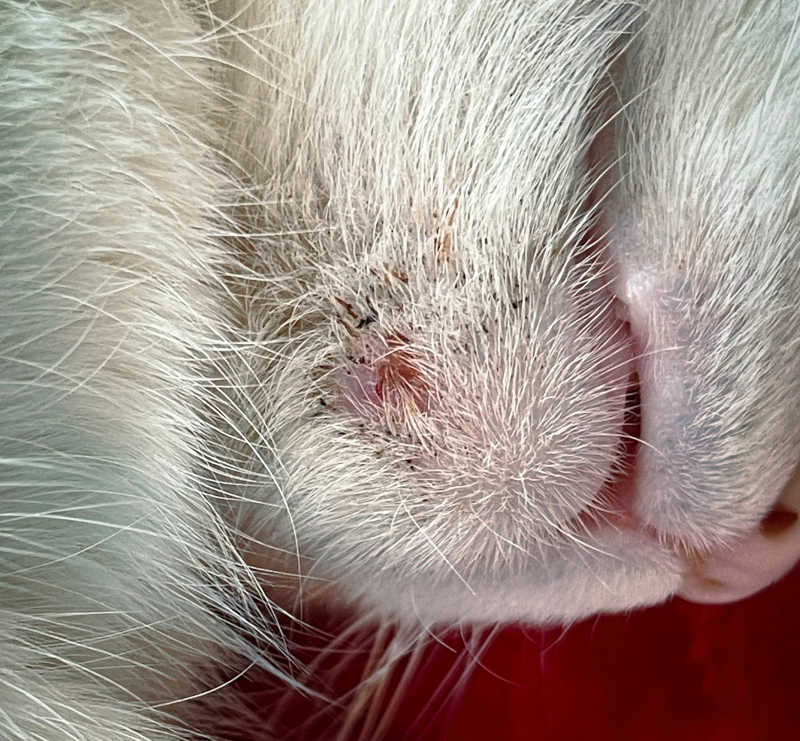
Is a cyst on a cat serious?
Cysts on cats are usually benign, not painful, and not serious. However, when you notice a lump on your cat, you should have your vet check it to make sure it isn’t something else like cancer. If your kitty has a cyst, the vet may advise leaving it cyst alone unless it becomes infected or causes trouble for your feline. The cyst may rupture and drain on its own. If the lump gets infected, your doctor will drain it or remove it surgically.
Types of cat cysts [with pictures]
There are several varieties of cysts in cats, as shown on the pictures below. However, the diagnosis and treatment for various types of cysts are similar. Let’s look at the types of cysts you are most likely to find on your cat.
1. True cysts
True cysts occur when sweat glands or other glands become blocked and the fluid builds up in the sac. When you encounter a true cyst, it will appear as a rounded lump with a bluish or translucent bump that’s soft to the touch, as shown on the cyst picture below.
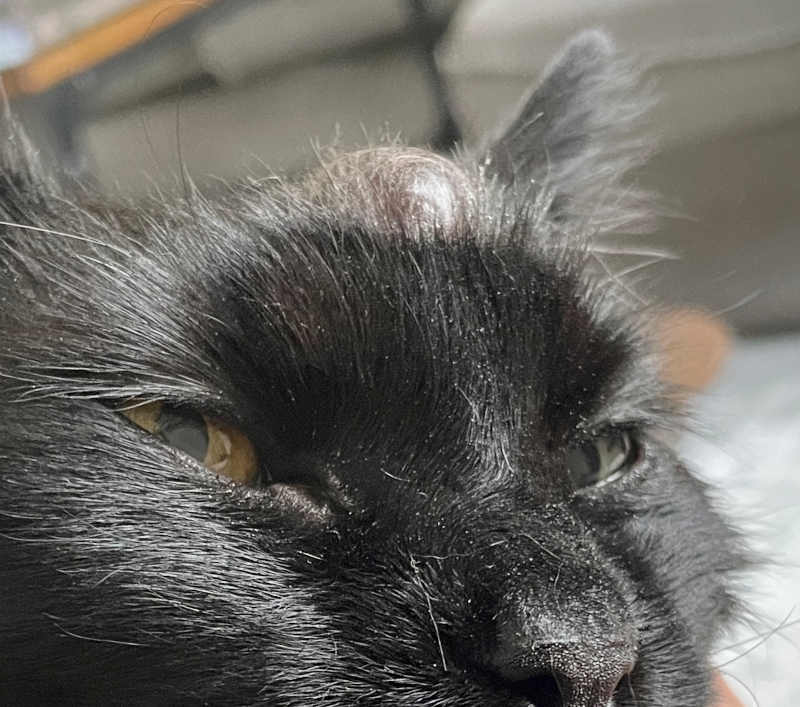
The wall of a true cyst usually has an inner lining of secretory cells that continue to secrete fluid. If you or your vet attempt to drain a true cyst, the fluid will build back up. Surgical removal is the only cure.
2. Sebaceous cysts
The most common type of cysts, sebaceous cysts, arise from a sebaceous gland and are usually benign. Pictured below is a sebaceous cyst on a cat’s skin. You can also click here to view a picture of a sebaceous cyst on a cat’s tail.

When a sebaceous gland clogs, the body builds a protective wall around the damaged tissue. The resulting sac fills with sebum and can be up to an inch in size. They can appear anywhere on the body but are most common on the head or at the base of the tail and often look like warts. Many times, sebaceous cysts can be ignored. Some will stop growing once the protective sac is full, but other cat sebaceous cysts rupture. If they become infected, they need to be drained or surgically removed.
3. Apocrine cysts
Feline apocrine cysts of the ear arise from the ceruminous glands in the ear canal. They appear as bluish-black lesions on the inner pinna. There are usually multiple lumps. Although mostly benign, the cysts can cause your kitty considerable pain if they become infected. The treatment of choice is surgical removal. Learn more about cysts in cats’ ears.
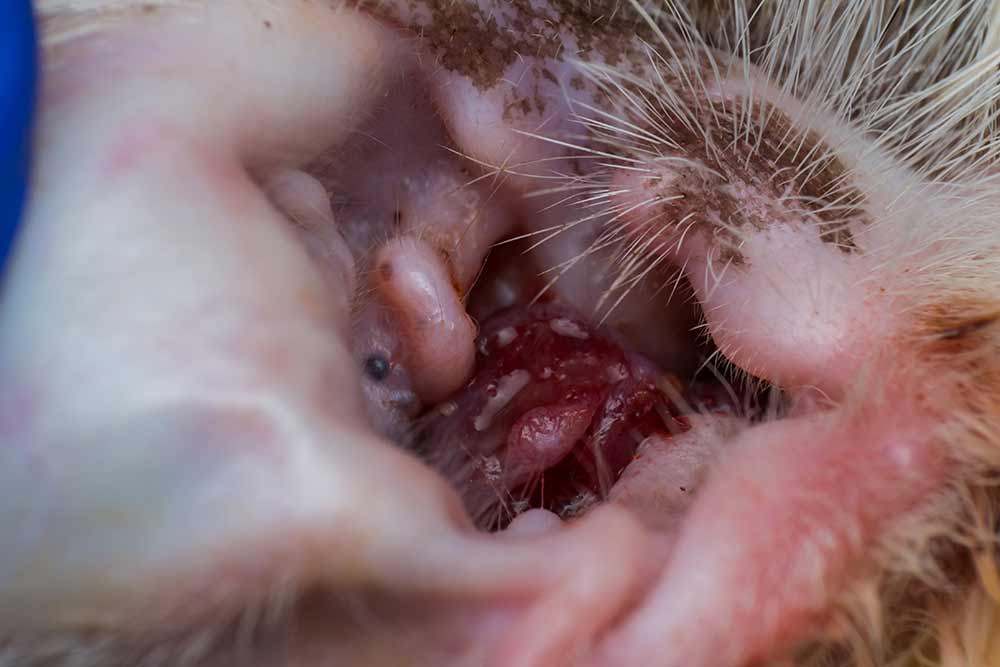
4. Follicular cysts
With follicular cysts, fluid or tissue collects in the hair follicle. This type is not as common in cats. One form of follicular cyst is cat acne. Similar to humans, you may notice white pimples or blackheads, as shown on the cyst picture below:

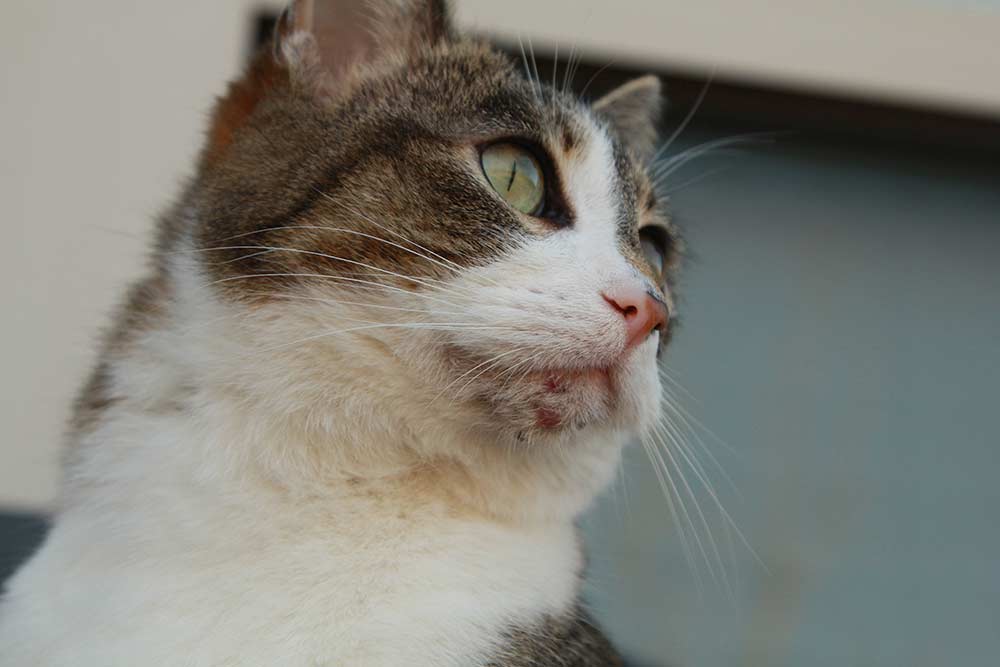
5. Dermoid cysts
Dermoid cysts develop in the womb as a result of tissue overgrowth. They may include hair, bones, or other solid tissue. When a dermoid cyst is found, the only treatment is surgical removal.

6. Feline lipomas
Lipomas in cats are benign fatty tumors that grow under the skin. They may appear in clusters or singly. These masses have a firm or soft, spongy consistency and can move fairly freely under the skin. Although harmless, it’s best to surgically remove lipomas because they tend to grow rapidly and can become uncomfortable or interfere with other tissues. Older, neutered males have the highest risk of developing lipomas.
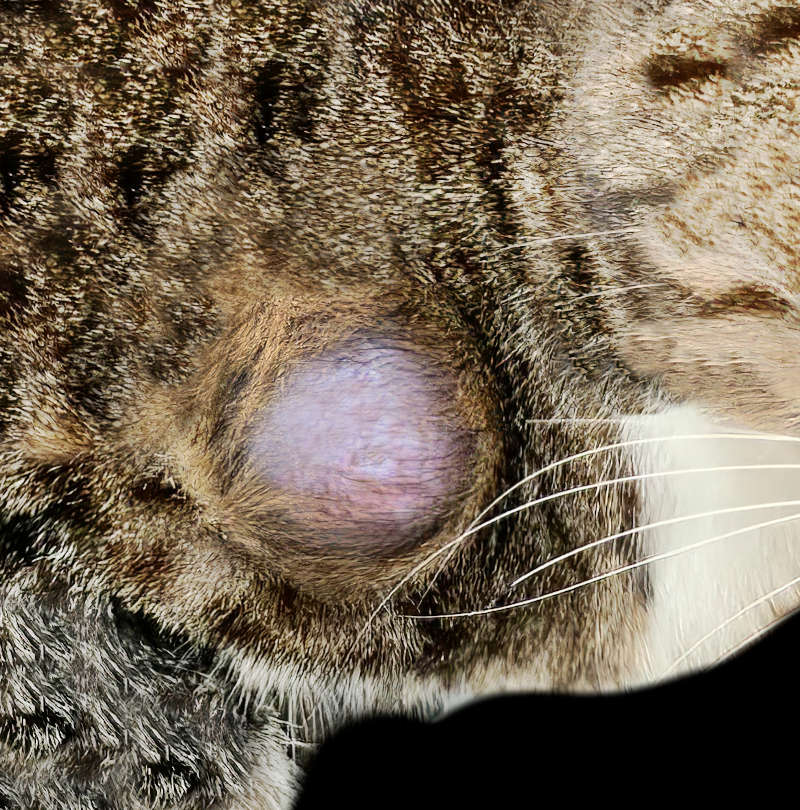
7. False cysts
These lumps look like a cyst, but they really aren’t. A false cyst arises from an injury when dead tissue and blood are trapped under the skin. These are not very common in cats but are usually along the flanks when they occur.
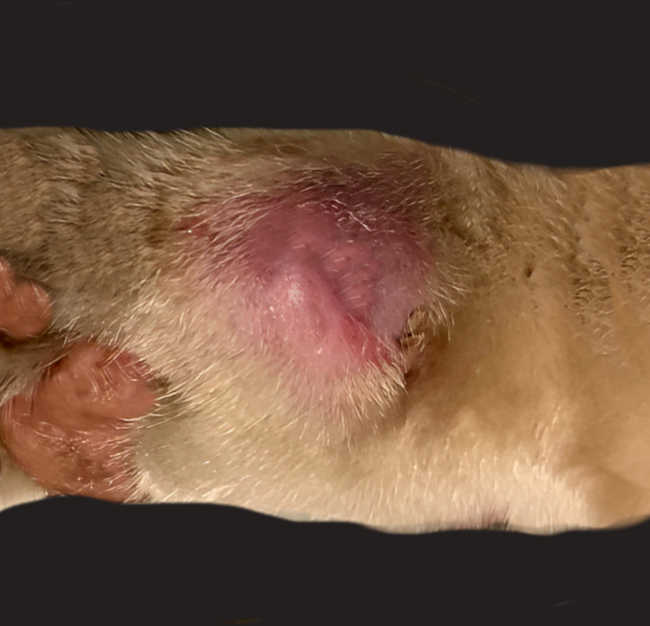
Pictures of cysts across your cat’s body (mouth, head, ear, eyes and tail) – and what it means
Certain cysts, like true cysts, can occur anywhere on a cat including a cyst on a cat’s eyelid or a cyst on the gums. However, other forms usually appear on specific parts of the body.
- Cat mouth cyst – Cysts in the mouth or gums can be due to injury, gum disease, or a dental issue. They can become painful or grow until they interfere with breathing and/or eating.
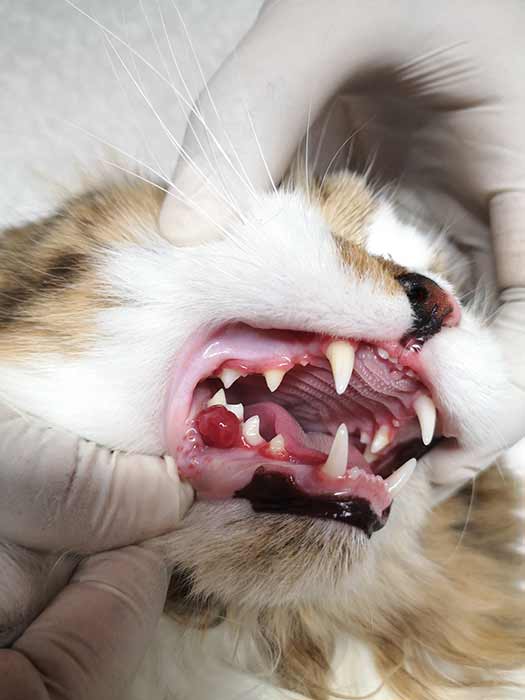
- Cat cyst on the head – Cysts on a cat’s head are often sebaceous cysts. The picture below shows a large cyst on a cat’s head:
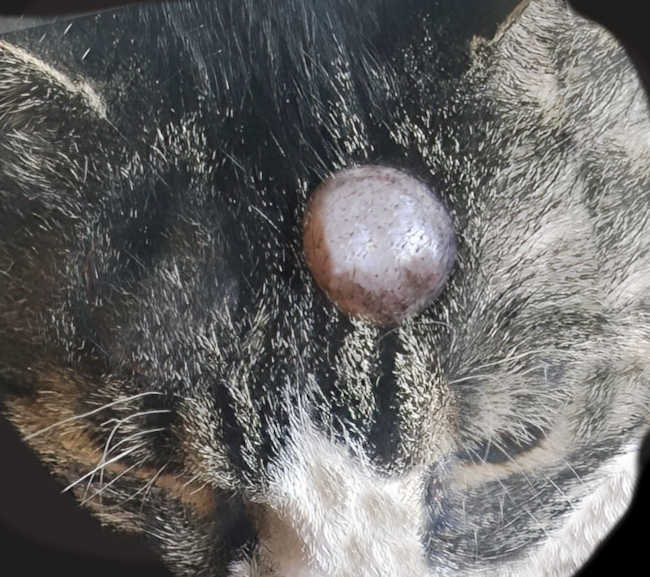
Many times, follicular cysts known as cat acne will appear under a cat’s chin. There may be one or several grey or yellow-colored round nodules.

- Cat ear cyst – Cysts in a cat ear are usually due to a blocked ceruminous gland in the ear canal. They appear as multiple blue-black lumps and are generally benign.

- Cat eye/eyelid cyst – Chalazion or cysts that appear on the eye or eyelid are often caused by a blocked meibomian gland that swells and fills with fluid.
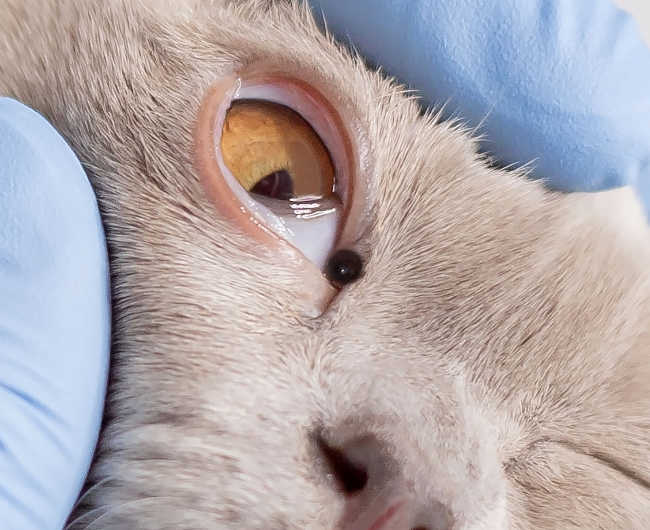
- Cyst on a cat’s tail – When you find a cyst at the base of the tail, it’s probably a sebaceous cyst known as a stud tail. Again, there can be one or more bumps that appear blue or white.

- Cat cyst on the neck, flank, or abdomen – Lipomas commonly occur in the subcutaneous tissues of the neck, flank, or abdomen. The picture below shows a lipoma on a dog:
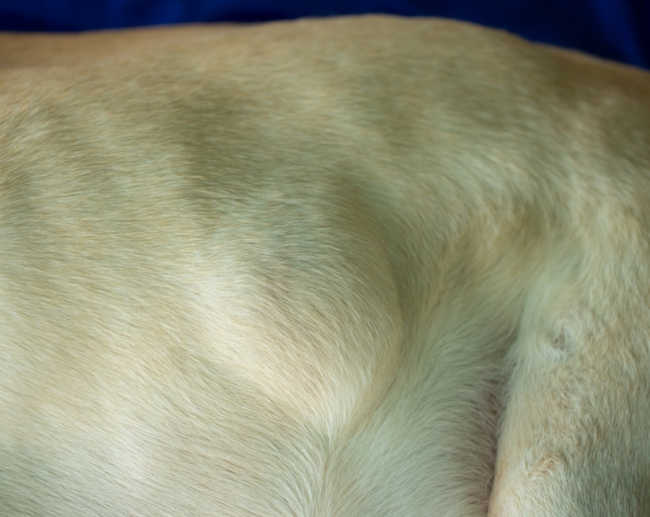
What causes cat cysts?
Blocked glands are the main cause of cysts in cats. Many times, glands become blocked because they are injured by trauma or sun damage. Infection or drug reactions may also trigger the development of cysts.
- True cysts usually come from blocked sweat glands.
- Sebaceous cysts happen when the sebaceous glands clog.
- With follicular cysts, the hair follicle becomes damaged, and the pore opening clogs.
- Apocrine cysts occur because the ceruminous gland closes off.
- When it comes to dermoid cysts, the cause is congenital. During embryonic development, the epidermal layer of the skin doesn’t close properly, and other tissues become trapped in the cyst.
- False cysts are due to an injury, or they may appear after an injection.
What are the visual characteristics of cysts on cats?
Certain cysts have distinctive appearances to help you distinguish them from other types of lumps and bumps. Refer to the pictures in the Types of Cysts section above.
- Follicular cysts are often singular, round bumps. They commonly appear on the head, neck, or trunk and are usually a bluish color. The contents of these cysts tend to be thick and yellowish or grey.
- True cysts are generally translucent or blue and appear as vesicles or nodules. The sac-like structure is filled with fluid, and it may ooze some yellow liquid. These cysts may occur in groups, especially around the ears and eyes.
- Sebaceous cysts are often singular bumps that are raised and may be white or blue. When a cat sebaceous cyst ruptures, it tends to ooze a thick discharge that is brownish or white and may resemble cottage cheese. Aside from stud tail, sebaceous cysts most commonly appear on the upper legs, torso, neck, or head.
- False cysts will appear dark, like a blood blister.
When should you call your veterinarian?
If you notice a new lump or bump on your cat, you should contact your veterinarian and schedule an exam. The doctor can examine the lesion or lesions and run diagnostic tests to determine the nature of the growth. Hopefully, it will be a benign cyst. If your cat is acting ill and you find a tumor, schedule an appointment as soon as possible. The growth could be more serious.
How are cysts diagnosed in a cat?
When you take your cat to the vet for an exam, he’ll take a history and examine the lumps or bumps. After assessing the size, consistency, color, and movement of the lesions, he’ll run some diagnostic tests.
1. Fine needle aspirate
With a fine needle aspirate, your vet will insert a needle into the lump or squeeze material out of an oozing cyst. The collected material is then examined under a microscope to examine the nature of the cells. This is sufficient to diagnose many types of lumps, but not all.
2. Biopsy
When a fine needle aspirate cannot provide a diagnosis, the vet may resort to a surgical biopsy. A piece of the mass or the entire lump may be removed and submitted to a pathology lab for examination.
What is the treatment for cysts in cats?
There are three possible ways to treat cysts.
- Do nothing – If the cyst isn’t overly large or bothering your cat, your veterinarian may recommend leaving it alone. The lesion may well rupture on its own. It’s also the option of choice if your pooch is too old or sick to tolerate surgery.
- Medical approach – Infected cysts or fluid-filled lumps can be drained. If your veterinarian recommends that you drain the cyst at home, practice good hygiene to prevent introducing infection. The vet may also prescribe antibiotics for your kitty. Cats with feline acne could benefit from regular cleaning with a medical wash.
- Surgical removal – If a cyst is making your dog uncomfortable or there are any concerns about the lump, it should be removed. This can be done in different ways.
-
- Electrocautery
- Cryotherapy
- Excision
Neutering is also a treatment option for a male cat with a stud tail because testosterone can be a contributing factor.
Can cysts go away on their own?
Some cysts may rupture and drain on their own, but the pocket can refill. In other cases, a cyst will sometimes resolve after your vet treats the underlying cause. However, surgical removal is the most reliable way to permanently deal with a cyst.
How do cysts typically progress in cats?
When a gland or hair follicle clogs or becomes damaged, your cat’s immune system tells the body to build a wall around the affected tissue. Once a pocket forms, it begins to fill with fluid or semisolid material. When the sac is full, the cyst may stop growing, or it may continue to expand until it ruptures.
Is there anything you can do at home if you notice a cyst on a cat?
If you notice a lump on your cat that looks like a cyst, contact your veterinarian and schedule an exam. The doctor can run diagnostic tests to confirm your suspicions. Once you have a proper diagnosis, there are some things you can do at home.
- Clean acne regularly – Use a medical cleanser on areas affected by acne to remove excess sebum and keep the area clean.
- Drain the cyst – With veterinary approval, you may be able to drain the cyst at home.
- Castor oil – You can try rubbing castor oil on the cyst to help treat it.
- Turmeric – Turmeric is a natural anti-inflammatory. Supplement your kitty’s diet with 1/16 tsp/10 lbs body weight of turmeric twice a day to minimize inflammation and expansion of the cyst.
How can I prevent future cysts from forming?
Because many cysts occur when skin glands become blocked, you may be able to prevent certain lesions like sebaceous and follicular cysts by practicing good hygiene with your kitty. Groom your cat routinely to remove dead skin and other debris. You can also use medicated wipes and shampoo to control excess oil on the skin.
Frequently asked questions
Are cysts on cats cancerous?
Cysts on cats are not cancerous or malignant, and they don’t metastasize. However, some subcutaneous cysts contain cells that become cancerous. Once they become malignant, these cysts can spread to other parts of the body. Any time you find a lump on your cat, you should have it examined by your vet.
Can I pop my cat’s cyst?
Depending on the type and location of cyst your cat has, you may be able to drain it at home. But consult with your veterinarian before you do anything. Popping a cat cyst may provide temporary relief, but it usually isn’t a permanent fix.
Is a cyst on a cat serious?
In most cases, a cyst on a cat is not serious. The best way to know whether a lump on your cat is something to be concerned about is to have it checked by your veterinarian.

